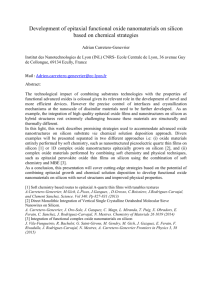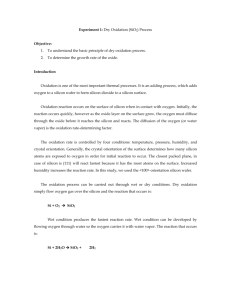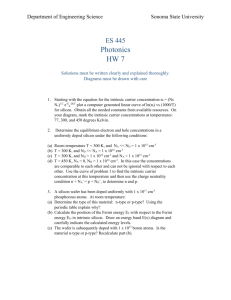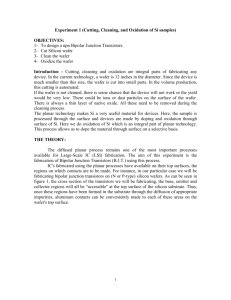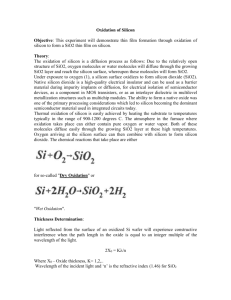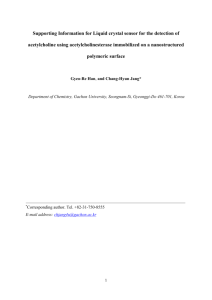Semiconductor Physics Problems & Solutions
advertisement
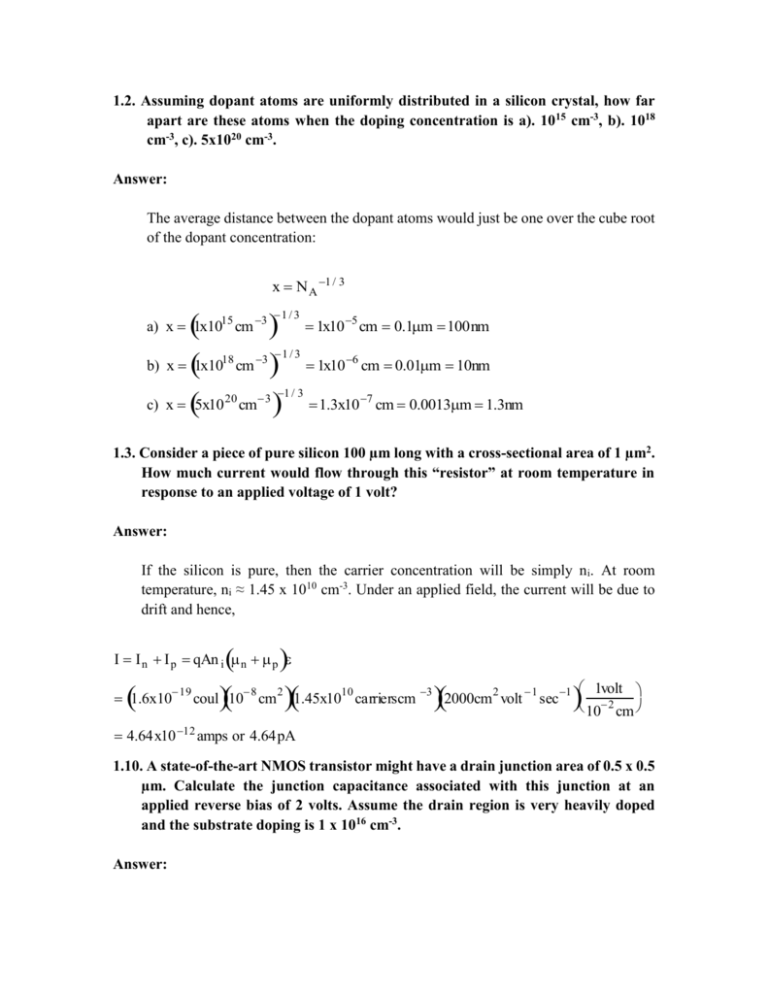
1.2. Assuming dopant atoms are uniformly distributed in a silicon crystal, how far apart are these atoms when the doping concentration is a). 1015 cm-3, b). 1018 cm-3, c). 5x1020 cm-3. Answer: The average distance between the dopant atoms would just be one over the cube root of the dopant concentration: x N A 1 / 3 b) x 1x10 c) x 5x10 a) x 1x1015 cm 3 18 cm 3 20 cm3 1 / 3 1x10 5 cm 0.1m 100nm 1 / 3 1x10 6 cm 0.01m 10nm 1 / 3 1.3x10 7 cm 0.0013m 1.3nm 1.3. Consider a piece of pure silicon 100 µm long with a cross-sectional area of 1 µm2. How much current would flow through this “resistor” at room temperature in response to an applied voltage of 1 volt? Answer: If the silicon is pure, then the carrier concentration will be simply ni. At room temperature, ni ≈ 1.45 x 1010 cm-3. Under an applied field, the current will be due to drift and hence, I I n I p qAn i n p 1.6x10 19 coul 10 8 cm 2 1.45x1010 carrierscm 3 2000cm 2 volt 1 sec 1 101voltcm 2 4.64x10 12 amps or 4.64pA 1.10. A state-of-the-art NMOS transistor might have a drain junction area of 0.5 x 0.5 µm. Calculate the junction capacitance associated with this junction at an applied reverse bias of 2 volts. Assume the drain region is very heavily doped and the substrate doping is 1 x 1016 cm-3. Answer: The capacitance of the junction is given by Eqn. 1.25. C S q S NA ND 1 A xd 2 NA ND i V The junction built-in voltage is given by Eqn. 1.24. ND is not specified except that it is very large, so we take it to be 1020 cm-3 (roughly solid solubility). The exact choice for ND doesn't make much difference in the answer. 20 3 10 cm 1016 cm 3 kT N DN A .0259volts ln i ln 10 3 2 q n 2i 1.45x10 cm 0.934 volts Since ND >> NA in this structure, the capacitance expression simplifies to C S qS 1 NA A W i V 2 1.6x1019 coul 11.7 1016 cm 3 8.86x10 14 Fcm 1 8 2 1.68x10 Fcm 22.934volts Given the area of the junction (0.25 x 10-8 cm2, the junction capacitance is thus 4.2 x 10-17 Farads. 3.2. A boron-doped crystal pulled by the Czochralski technique is required to have a resistivity of 10 Ω cm when half the crystal is grown. Assuming that a 100 gm pure silicon charge is used, how much 0.01 Ω cm boron doped silicon must be added to the melt? For this crystal, plot resistivity as a function of the fraction of the melt solidified. Assume k0 = 0.8 and the hole mobility µp = 550 cm2 volt-1 sec-1. Answer: Using the mobility value given, and 1 we have: qNA 10 Ω cm NA = 1.14 x 1015 cm-3 and 0.01 Ω cm NA = 1.14 x 1018 cm-3 k 1 From Eqn. 3.38, CS CO k O 1 f O and we want CS = 1.14 x 1015 cm-3 when f = 0.5. Thus, solving for C0 the initial doping concentration in the melt, we have: C0 But C 0 1.14x1015 1 0.50.2 1.24x1015 cm3 0.8 I0 # of impurities (Doping)(Vol. of 0.01 cm) V0 unit vol of melt Vol 100 gm Si C0 Wgt added of 0.01 cm Si = 100gm 0.109gm Doping The resistivity as a function of distance is plotted below and is given by x 1 1 f 1k 0 11.5cm 1 f 0.2 qNA x qC0 k 0 Resistivity 0 0.2 0.4 0.6 0.8 1 Fraction Solidified - f 3.3. A Czochralski crystal is pulled from a melt containing 1015 cm-3 boron and 2x1014 cm-3 phosphorus. Initially the crystal will be P type but as it is pulled, more and more phosphorus will build up in the liquid because of segregation. At some point the crystal will become N type. Assuming kO = 0.32 for phosphorus and 0.8 for boron, calculate the distance along the pulled crystal at which the transition from P to N type takes place. Answer: We can calculate the point at which the crystal becomes N type from Eqn. 3.38 as follows: k 0 1 CS Phos C0 k 0 1 f k 0 1 CS Boron C0 k0 1 f 14 2x10 0.321 f 0.68 0.81 f 15 10 0.2 At the point where the cross-over occurs to N type, these two concentrations will be equal. Solving for f, we find f 0.995 Thus only the last 0.5% of the crystal is N type. 3.6. Suppose your company was in the business of producing silicon wafers for the semiconductor industry by the CZ growth process. Suppose you had to produce the maximum number of wafers per boule that met a fairly tight resistivity specification. a). Would you prefer to grow N type or P type crystals? Why? b). What dopant would you use in growing N-type crystals? What dopant would you use in growing P type crystals? Explain Answer: a). Boron has the segregation coefficient closest to unity of all the dopants. Thus it produces the most uniform doping along the length of a CZ crystal. Thus P type would be the natural choice. b). For P type, the obvious (and only real choice) is boron as explained in part a). For N type crystals Fig. 3-18 shows that either P or As would be a reasonable choice since their segregation coefficients are quite close and are better than Sb. Table 3-2 indicates that P might be slightly preferred over As because its kO value is slightly closer to 1. 4.1. An IC manufacturing plant produces 1000 wafers per week. Assume that each wafer contains 100 die, each of which can be sold for $50 if it works. The yield on these chips is currently running at 50%. If the yield can be increased, the incremental income is almost pure profit because all 100 chips on each wafer are manufactured whether they work or not. How much would the yield have to be increased to produce an annual profit increase of $10,000,000? Answer: At 1000 wafers per week, the plant produces 52,000 wafers per year. If each wafer has 50 good die each of which sells for $50, the plant gross income is simply Income = (52,000)(50)($50) = $130,000,000 per year. To increase this income by $10,000,000 requires that the yield increase by 10 7.7% 130 4.3. As MOS devices are scaled to smaller dimensions, gate oxides must be reduced in thickness. a. As the gate oxide thickness decreases, do MOS devices become more or less sensitive to sodium contamination? Explain. b. As the gate oxide thickness decreases, what must be done to the substrate doping (or alternatively the channel VTH implant, to maintain the same VTH? Explain. Answer: a). From the text, Na+ contamination causes threshold voltage instabilities in MOS devices. Also from Eqn. 4.1, the threshold voltage is given by VTH VFB 2f 2S qNA 2 f COX qQM C OX As the gate oxide thickness decreases, COX increases, so the same amount of mobile charge QM will have less effect on VTH as oxides get thinner. Therefore MOS devices are less sensitive to sodium contamination. b). Using the same expression for VTH as in part a), we observe that as the oxide thickness decreases, (COX increases), to maintain the same VTH, NA will have to increase. NA will actually have to increase by the square root of the oxide thickness decrease to keep VTH constant. 4.4. A new cleaning procedure has been proposed which is based on H 2O saturated with O2 as an oxidant. This has been suggested as a replacement for the H2O2 oxidizing solution used in the RCA clean. Suppose a Si wafer, contaminated with trace amounts of Au, Fe and Cu is cleaned in the new H2O/O2 solution. Will this clean the wafer effectively? Why or why not? Explain. Answer: As described in the text, cleaning metal ions off of silicon wafers involves the following chemistry: M Mz ze The cleaning solution must be chosen so that the reaction is driven to the right because this puts the metal ions in solution where they can be rinsed off. Since driving the reaction to the right corresponds to oxidation, we need an oxidizing solution to clean the wafer. H2O/O2 is certainly an oxidizing solution. But whether it cleans effectively or not depends on the standard oxidation potential of the various possible reactions. From Table 4-3 in the text, we have: Oxidant/ Reductant Standard Oxidation Potential (volts) Oxidation-Reduction Reaction SiO2/Si 0.84 Si 2H2 O SiO 2 4H 4e Fe 3 /Fe 0.17 Fe Fe3 3e Cu 2 /Cu -0.34 Cu Cu 2 2e O2 /H2O -1.23 2H2O O2 4H 2e Au3 /Au -1.42 Au Au3 3e The stronger reactions (dominating) are at the bottom. Thus the H2O/O2 reaction will clean Fe and Cu, but it will not clean Au off the wafer. 4.5. Explain why it is important that the generation lifetime measurement illustrated in Figure 4-19 is done in the dark. Answer: The measurement depends on measuring carriers generated thermally in the silicon substrate (or at the surface). If light is shining on the sample, then absorbed photons can also generate the required carriers. As a result, the extracted generation lifetime with the light on would really be measuring the intensity of the incident light and not a basic property of the silicon material. 5.1. Calculate and plot versus exposure wavelength the theoretical resolution and depth of focus for a projection exposure system with a NA of 0.6 (about the best that can be done today). Assume k1 = 0.6 and k2 = 0.5 (both typical values). Consider wavelengths between 100 nm and 1000 nm (DUV and visible light). ). Indicate the common exposure wavelengths being used or considered today on your plot (g-line, i-line, KrF and ArF). Will an ArF source be adequate for the 0.13 µm and 0.1 µm technology generations according to these simple calculations? Answer: The relevant equations are simply R k1 0.6 and DOF = k 2 0.5 2 NA 0.6 NA 0.62 These equations are plotted below. Note that the ArF (193 nm) will not reach 0.13 µm or 0.1 µm resolution according to these simple calculations. In fact, with more sophisticated techniques such as phase shift masks, off axis illumination etc., ArF is expected to reach 0.13 µm and perhaps the 0.1 µm generations. 1.4 1.2 Depth of Focus Resolution, DOF µm 1 i-line ArF 0.8 KrF Resolution g-line 0.6 0.4 0.2 0 0 200 400 600 800 1000 1200 Exposure Wavelength nm 5.3. An X-ray exposure system uses photons with an energy of 1 keV. If the separation between the mask and wafer is 20 µm, estimate the diffraction limited resolution that is achievable by this system. Answer: The equivalent wavelength of 1 keV x-rays is given by hc E h 4.14x10 15 eV sec 3x1010 cm sec 1 hc E 10 3 eV 1.24x10 7 cm 1.24 nm X-ray systems operate in the proximity printing mode, so that the theoretical resolution is given by Eqn. 5.12: Re solution g 1.24x10 3 m 20m 0.15m 5.8. As described in this chapter, there are no clear choices for lithography systems beyond optical projection tools based on 193-nm ArF eximer lasers. One possibility is an optical projection system using a 157-nm F2 excimer laser. a. Assuming a numerical aperture of 0.8 and k1 = 0.75, what is the expected resolution of such a system using a first order estimate of resolution? b. Actual projections for such systems suggest that they might be capable of resolving features suitable for the 2009 0.07 µm generation. Suggest three approaches to actually achieving this resolution with these systems. Answer a). The simple formula for resolution is R k1 0.157m 0.75 0.147m NA 0.8 b). The calculated resolution in part a is a factor of two larger than required for the 0.07 µm generation. Therefore some “tricks” will have to be used to actually achieve such resolution. There are a number of possibilities: 1. Use of phase-shift masks. This technique, discussed in this chapter, has the potential for significant resolution improvements. It works by designing a more sophisticated mask. Simple masks are digital - black or white. Phase shifting adds a second material to the mask features, usually at the edges which shifts the optical phase and sharpens up the aerial image. Sophisticated computer programs are required to design such masks. 2. Use of optical proximity correction in the mask design. This is another approach to designing a better mask and as discussed in class, can also improve resolution significantly. The approach involves adding extra features to the mask, usually at corners where features are sharp, to compensate for the high frequency information lost to diffraction effects. 3. Off-axis illumination. This allows the optical system to capture some of the higher order diffracted light and hence can improve resolution. 5.9. Current optical projection lithography tools produce diffraction limited aerial images. A typical aerial image produced by such a system is shown in the simulation below where a square and rectangular mask regions produce the image shown. (The mask features are the black outlines, the calculated aerial image is the grayscale inside the black rectangles.) The major feature of the aerial image is its rounded corners compared to the sharp square corners of the desired pattern. Explain physically why these features look the way they do, using diffraction theory and the physical properties of modern projection optical lithography tools. Answer: Modern optical projection lithography systems are limited in the resolution they can achieve by diffraction effects. The finite size of the focusing lens means that the high order diffraction components are “lost” and are therefore not available to help in printing a replica of the mask image. But the high frequency spatial components are exactly the components that contain information about “sharp” features, i.e. corners etc. Thus the projected aerial image loses this information and corners become rounded. The only ways to improve the image are by using shorter wavelength light, or a higher NA lens. 5.10. Future optical lithography systems will likely use shorter exposure wavelengths to achieve higher resolution and they will also likely use planarization techniques to provide “flat” substrates on which to expose the resist layers. Explain why “flat” substrates will be more important in the future than they have been in the past. Answer: As the wavelength of the exposure system decreases, the depth of focus of the exposure system also decreases. Thus it will be necessary to make sure that the resist in which the image is to be exposed, is flat and does not require much depth of focus. Planarization techniques will be required to accomplish this. This could mean CMP to planarize the substrate before the resist is applied, or it could mean using a spun on resist which planarizes the substrate and which is then covered with a thin, uniform imaging resist layer. 6.4. Construct a HF CV plot for a P-type silicon sample, analogous to Fig. 6-9. Explain your plot based on the behavior of holes and electrons in the semiconductor in a similar manner to the discussion in the text for Fig. 6.9. Answer: - VG a) C CO CO h+ P Silicon Doping = N A b) - + + VG - - - - - - -- VG C CO CO xD CD h+ - c) + VG ++VG C QG QI QD CO -- - --- -- - - xDMax - - CO CDMin h+ Electrons - VTH + VG The C-V plot looks basically the same as the N substrate example in the text, that we discussed in class, except that the horizontal axis is flipped. For negative applied gate voltages, the majority carrier holes in the substrate are attracted to the surface. This is the accumulation region a) above. We measure just COX for the capacitance since there is no depletion in the substrate. For + VG, the holes are driven away from the surface creating first a depletion region as in b) and finally an inversion layer of electrons as in c). The measured capacitance drops as we move into depletion and finally reaches a minimum value after an inversion layer forms. The C-V curves shown are high frequency curves. As discussed in the text, the capacitance remains at its minimum value for + VG values greater than VTH because the inversion layer electrons cannot be created or destroyed as fast as the signal is changing. Hence the small AC signal must “wiggle” the bottom of the depletion region to balance ∆VG. 6.6. In a small MOS device, there may be a statistical variation in VT due to differences in QF from one device to another. In a 0.13 µm technology minimum device (gate oxide area = 0.1µm x 0.1µm) with a 2.5nm gate oxide, what would the difference in threshold voltage be for devices with 0 or 1 fixed charge in the gate oxide? Answer: The oxide capacitance is 14 0.110 4 0.1 10 4 A 3.9 8.854 10 Cox d 2.5 107 1.38 10 16 The change in threshold voltage is given by 1.6 1019 1 qQF VT 16 1.1 mV Cox 1.38 10 This shows that a single electron trap in a gate oxide will have a negligible effect on the threshold voltage at this technology generation. 6.12 A silicon wafer is covered by an SiO2 film 0.3 m thick. a. What is the time required to increase the thickness by 0.5 m by oxidation in H2O at 1200˚C? b. Repeat for oxidation in dry O2 at 1200˚C. Answer: We will perform the calculation for <111> silicon wafers. For <100> wafers, the linear rate constant should be divided by 1.68. a. At 1200˚C, in H2O 0.78 B 3.86 102 exp 0.829 m 2 / hr kT B 2.05 1.63 108 exp 15.86 m / hr kT A A 0.052 m The initial oxide, if grown at 1200˚C would have taken this long to grow x2i Ax i 0.32 0.0520.3 0.127 hr B 0.829 The time required to grow 0.8 m at 1200˚C is x2i Ax i 0.82 0.0520.8 0.822 hr B 0.829 Thus, the time required to add 0.5 m to an existing 0.3 m film is 0.822 0.127 0.695 hr or 41.7 minutes. b. At 1200˚C, in dry oxygen 1.23 B 7.72 102 exp 0.048 m 2 / hr k(1200 273) B 2.0 6.23 106 exp 0.899 m / hr kT A A 0.053 m The initial oxide would have taken 2.206 hours to grow in dry oxygen, it would require 14.217 hours to grow 0.8 m , thus would require an additional 12 hours to add 0.5 m to an existing 0.3 m film. 6.13. Suppose an oxidation process is used in which (100) wafers are oxidized in O 2 for three hrs. at 1100˚C, followed by two hrs. in H2O at 900˚C, followed by two hrs in O2 at 1200˚C. Use Figs. 6-19 and 6-20 in the text to estimate the resulting final oxide thickness. Explain how you use these figures to calculate the results of a multi-step oxidation like this. Answer: We can use these figures to estimate the oxide thickness as follows. First, we use Fig. 6-19 for the first dry oxidation cycle A three hour oxidation at 1100˚C produces an oxide thickness of about 0.21 µm. We next use Fig. 6-20 for the wet oxidation as shown below. The oxidation is 2 hrs in H2O at 90 ˚C. We start by finding the point on the 900˚C curve that corresponds to 0.21 µm since this is the starting oxide thickness. This is point A. We then move along the 900˚C curve by two hours to point B. This corresponds to a thickness of about 0.4 µm which is the thickness at the end of the wet oxidation. 2 1.6 1100 ÞC 1.2 1000 ÞC 0.8 O xi d e T h ic k n es s m ic ro n s 900 ÞC 0.4 B 800 ÞC A 700 ÞC 0 0 1 2 3 4 5 6 Time - hours 7 8 9 10 We now go back to Fig. 6-19 for the final dry O2 cycle. This process is 2 hrs at 1200˚C. We start by finding the point on the 1200˚C curve that corresponds to a starting oxide thickness of 0.4 µm. This is point A below. We then increment the time by 2 hrs along the 1200˚C curve, to arrive at a final oxide thickness of about 0.5 µm. 6.18. Silicon on Insulator or SOI is a new substrate material that is being considered for future integrated circuits. The structure, shown below, consists of a thin single crystal silicon layer on an insulating (SiO2) substrate. The silicon below the SiO2 provides mechanical support for the structure. One of the reasons this type of material is being considered, is because junctions can be diffused completely through the thin silicon layer to the underlying SiO2. This reduces junction capacitances and produces faster circuits. Isolation is also easy to achieve in this material, because the thin Si layer can be completely oxidized, resulting in devices completely surrounded by SiO2. A LOCOS process is used to locally oxidize through the silicon as shown on the right below. Assuming the LOCOS oxidation is done in H2O at 1000˚C, how long will it take to oxidize through the 0.3 µm silicon layer? Calculate a numerical answer using the Deal Grove model. Answer: To oxidize completely through a 0.3 µm silicon layer, we will need to grow (2.2)(0.3 µm) = 0.66 µm of SiO2. At 1000˚C in H2O, the Deal Grove rate constants are given by (Table 6-2): 0.78eV B 3.86x102 exp 0.316m 2hr 1 kT B 1.63x108 2.05eV exp 0.747mhr 1 A 1.68 kT t 0.662 0.316 0.66 2.25 hours 0.747 6.23. As part of an IC process flow, a CVD SiO 2 layer 1.0 µm thick is deposited on a <100> silicon substrate. This structure is then oxidized at 900˚C for 60 minutes in an H2O ambient. What is the final SiO2 thickness after this oxidation? Calculate an answer, do not use the oxidation charts in the text. Answer: At 900˚C in H2O, the oxidation rate constants are given by: 0.78 2 -1 2 -1 B 3.86x10 exp m hr 0.17 m hr 5 8.62x10 1173 2 B 1.63x108 2.05 -1 -1 exp m hr 0.152 m hr 5 A 1.68 8.62x10 1173 The initial oxide on the wafer is 1.0 µm thick. This corresponds to a of 0.17 0.152 12.46 hours 0.17 12 1 Thus the final oxide thickness is given by 0.17 13.46 xo 1 1 1.064 m 2 0.152 1.112 4 0.17 Thus not much additional oxide grows. Chapter 7 Problems 7.1. A resistor for an analog integrated circuit is made using a layer of deposited polysilicon 0.5 µm thick, as shown below. Polysilicon SiO2 Si 16 3 (a) The doping the polysilicon is 1 10 cm . The carrier mobility 100 cm 2 V1 sec1 is low because of scattering at grain boundaries. If the resistor has L=100µm, W=10µm, what is its resistance in Ohms? (b) A thermal oxidation is performed on the polysilicon for 2 hours at 900˚C in H2 O . Assuming B/A for polysilicon is 2/3 that of <111> silicon, what is the polysilicon thickness that remains. (c) Assuming that all of the dopant remains in the polysilicon (i.e. does not segregate to oxide), what is the new value of the resistor in (a). Assume the mobility does not change. Answer: (a) 1 1 6.25cm 16 19 nq 1 10 1.6 10 100 S R (b) 6.25 125k x j 0.5 10 4 100 1.25M (10 squares ) 10 S The linear rate coefficient at 900˚C is 2 B 2.05 8 1 A poly 3 1.63 10 exp kT 0.170 m hr The parabolic rate constant for poly is unchanged: 0.78 Bpoly 3.86 10 2 exp 0.172 m 2 hr 1 kT A poly 1.01 m The oxide thickness is xo xo A t 1 1 2 2 A / 4B 1.01 2 1 1 0.27 m 2 1.012 / 40.172 This oxide consumes a silicon thickness of 0.45*0.27=0.12 µm, leaving a remaining polysilicon thickness of 0.5-0.12=0.38 µm and contains all the dopant with a concentration of 0.5 1 1016 1.31 1016 cm 3 0.38 (c) Since the concentration has gone up and the thickness has gone down by the same factor, the polysilicon restivity and hence the resistance of the line remains the same. 7.4. Suppose we perform a solid solubility limited predeposition from a doped glass source which introduces a total of Q impurities / cm2. (a) If this predeposition was performed for a total of t minutes, how long would it take (total time) to predeposit a total of 3Q impurities / cm2 into a wafer if the predeposition temperature remained constant. (b) Derive a simple expression for the Dt drivein which would be required to drive the initial predeposition of Q impurities / cm2 sufficiently deep so that the final surface concentration is equal to 1% of the solid solubility concentration. This can be expressed in terms of Dt predep and the solid solubility concentration CS . Answer: (a) Q 2CS Dt Q t 3Q 9t (b) Q 0.01CS Dt C0,t drive in Q 2 2CS Dt predep Dt predep Dt drivein Dt drive in 0.01 2 200 Dt predep 7.7. A boron diffusion is performed in silicon such that the maximum boron concentration is 1 x 1018 cm-3. For what range of diffusion temperatures will electric field effects and concentration dependent diffusion coefficients be important? Answer: Electric field effects and concentration dependent diffusion are both important when the doping concentration exceeds the intrinsic electron (or hole) concentration. The intrinsic or background electron concentration is n i which increases with higher temperature. This provides a background sea of electrons or holes in the lattice at a given temperature. If the doping exceeds this concentration, then these extrinsic effects are important. 18 3 When the temperature is below the temperature where n i 1 10 / cm , these effects will become dominant since they often depend on n / n i (where n N A or n N D to a first approximation). 3 0.605 n i 3.9 1016 T 2 exp kT 18 3 By trial and error, n i 1 10 / cm at T=720C. Therefore, extrinsic effects become important below 720˚C. 7.15. A silicon wafer is uniformly doped with boron (2 x 1015 cm-3) and phosphorus (1 x 1015 cm-3) so that it is net P type. This wafer is then thermally oxidized to grow about 1 µm of SiO2. The oxide is then stripped and a measurement is made to determine the doping type of the wafer surface. Surprisingly it is found to be N type. Explain why the surface was converted from P to N type. Hint: Consider the segregation behavior of dopants when silicon is oxidized. Answer: The boron segregates preferentially into the growing oxide, thus depleting the surface concentration in the silicon. The phosphorus on the other hand preferentially segregates (piles-up) on the silicon side of the interface. Both of these effects act in the same direction and tend to make the surface of the silicon more N-type. It is for this reason that a P-type “channel stop” implant is almost always needed under a locally oxidized lightly doped P-type region, to prevent depletion of the P-type dopant in the substrate and in the worst case to prevent an N-type channel from forming. * 7.20. Fig. 7.38 shows that a wet oxidation produces a significantly higher C I / C I than does a dry O2 oxidation. Explain quantitatively why this should be the case. Answer: Because CI dx dt a faster oxidation rate produces a higher interstitial supersaturation. Thus, wet * oxidation produces a higher C I / C I than dry oxidation, for the same time at the same temperature. Chapter 8 Problems 8.1. Arsenic is implanted into a lightly doped p-type Si substrate at an energy of 75keV. The dose is 1 1014 / cm2 . The Si substrate is tilted 7˚ with respect to the ion beam to make it appear amorphous. The implanted region is assumed to be rapidly annealed so that complete electrical activation is achieved. What is the peak electron concentration produced? Answer: From Fig. 8-3, the range and standard deviation for 75 keV arsenic are RP 0.05m RP 0.02m The peak concentration is CP Q 2 R P 1 1014 4 2 0.02 10 2 1019 cm 3 Assuming all the dose is active, then the peak electron concentration is equal to the peak dopant concentration. 8.4. How thick does a mask have to be to reduce the peak doping of an implant by a factor of 10,000 at the mask/substrate boundary. Provide an equation in terms of the Range and the Standard Deviation of the implant profile. Answer: * * We want to reduce the peak doping N P in the mask at range R P by 10,000 at the mask/substrate boundary. We will use the equation which describes the profile of an implant in a mask layer * 2 d R P * * N (d) N P exp *2 2R P When N* (d) 4 * 10 NP we have d R *P 4.3R*P 8.6. The equations below provide a reasonable analytical description for some of the diffusion processes indicated schematically in the diagrams on the following page. Put the equation number (a-f) on each figure that is the best match. Equations may be reused, or multiple equations may describe the same figure. A brief explanation is required for each figure. (a) C(x, t) C x erfc 2 Dt 2 (b ) C(x, t) (c ) C(x, t) (d ) x 2 Q exp 2 Dt 2 Dt C(x, t) Cerfc (e) C(x, t) (f) Q x2 exp (D1t 1 D2t 2 ) 4(D1t1 D2 t 2 ) x 2 Dt x 2 Q exp Dt 4Dt C(x, t) (x R )2 P exp 2 2 2(R P 2Dt) 2(R P 2Dt) Q Answer: (a) Describes a complementary error function in-diffusion, where the surface concentration is half the peak concentration in the background. (f) Describes a one-sided Gaussian profile that has some addition diffusion time. (g) Describes a delta function that diffuses as a Gaussian profile in an infinite medium. (h) Describes a complementary error function diffusion from a constant surface concentration. (i) Describes a one-sided Gaussian diffused profile near a reflecting surface. (j) Describes an implanted profile in an infinite medium that has some extra diffusion time. (a) C(x, t) C x erfc 2 Dt 2 x C(x, t) Cerfc 2 Dt C(x, t) (x R P )2 exp 2(R 2P 2Dt) 2(R 2P 2Dt) Q C(x, t) Q x2 exp (D1t 1 D2t 2 ) 4(D1t1 D2 t 2 ) C(x, t) C(x, t) x2 Q exp Dt 4Dt x 2 Q exp 2 Dt 2 Dt 8.10. An implant machine for 300 mm wafers is required to have a throughput of 60 wafers per hour. What beam current is required in order to implant a 15 2 source/drain region in a CMOS device with a dose of 1 10 cm ? Answer: The dose Q is given by Q I dt qA where the area A is 30 cm x 30 cm (normally a square pattern is used) and q 1.6 10 19 C . Hence I=2.4mA 8.13. In two separate experiments, As and then B are implanted through a thin SiO 2 layer into the underlying substrate. As a result of the implantation, some of the oxygen atoms in the SiO2 layer are knocked into the silicon substrate. Would you expect the As or the B to produce more oxygen knock-ons? Why? Answer: We will assume that the As and B are implanted at the same energy. The lighter B atom will slow down mainly by electronic stopping, which will not displace many atoms in the thin oxide layer. On the other hand, the heavy As atom will slow down mainly by nuclear collisions, which will knock on many of the oxygen atoms in the oxide layer. Thus, As produces more oxygen knock-ons than boron. 8.17. The diffusion of a buried antimony layer is only 20% of its normal diffusion in an inert ambient after a phosphorus implant is performed at the surface of a silicon wafer. The phosphorus diffusion coefficient is itself enhanced by a factor of 4 (400%). (a) Suggest a qualitative reason for this observation. (b) Assuming that the phosphorus diffuses completely by an interstitial mechanism, calculate how much of the antimony diffusion is mediated by interstitials and how much by vacancies. Answer: (a) The phosphorus implant creates an equivalent dose of +1 interstitials, which diffuse into the substrate and enhance the diffusion of the phosphorus itself. The interstitials also recombine with vacancies and depress the vacancy concentration, leading to retarded diffusion of the buried antimony layer. (b) The antimony retardation is given by D R 0.2 D* Sb If phosphorus diffuses completely by an interstitial mechanism, its diffusion * enhancement represents the interstitial supersaturation C I / C I D D* E 4.0 P There are several formulas to use to obtain the fraction of the antimony that diffuses by vacancies: fV 1 0.2 0.8 A stricter bound uses the fact that the phosphorus diffusion is simultaneously enhanced 0.2 fV 1 0.95 4.0 while the expression in Eqn. 7-73 uses only the antimony retardation, but assumes that interstitial and vacancy recombination is at equilibrium fV 0.5 0.5 1 (0.2)2 0.989 8.20. An NMOS transistor is being built and an ion implantation is done after the gate oxide is grown and before the gate polysilicon deposition, in order to adjust the threshold voltage by +1volt. (a) Which dopant should be used? (b) Calculate the dose of the dopant if the oxide thickness is 10 nm. Answer: (a) An NMOS transistor has an n-type source and drain and hence needs an n-type channel to connect the source and drain when producing drive current. This requires the p-type substrate, which isolates the source and drain when the device is in the off state, to be inverted during the on state when the MOSFET provides drive current. Hence a positive gate voltage is applied under normal operation when switching on the device, producing an inversion layer. More positive charge in the channel will make the device harder to switch on and shift the threshold from V to (V+1) Volt, so the channel charge should be boron or indium. (b) If the gate oxide is 10 nm, the oxide capacitance per unit area is Cox 0 t ox Cox 3.9 8.854 10 14 100 10 and the Vt shift is given by VT 1.0 8 345.3nF qQ C ox 1.6 10 19 Q 9 345.3 10 so that Q 2.16 1012 cm2 Chapter 9 Problems 9.1. What would you expect would happen to the threshold voltage of a MOS transistor if the gate oxide was deposited using SiH 4 2O2 SiO 2 2H2O rather than thermally grown? Answer: The threshold voltage is likely to change because of fixed charge at the interface for a deposited interface compared to a thermally grown interface. The change in threshold voltage is given by qQf C OX and shifts by an amount determined by the quantity of fixed charge at the interface. VT 9.2. What are the two commonly observed rate limiting steps in silicon epitaxial growth? Under what conditions do they normally dominate the overall deposition rate? Answer: The two commonly observed rate limiting steps in silicon epitaxial growth are mass transfer (diffusion) through the stagnant boundary layer and surface reaction(s). The former normally dominates at higher temperatures and higher total pressures, and the latter at lower temperatures and lower pressures. 9.3. In an epitaxial deposition, under mass transfer limited conditions, is it more important to control the reactor temperature or the source gas composition in the gas stream to obtain reproducible results? Why? Answer: Under mass transfer limited conditions it is more important to control the source gas composition in the gas stream to obtain reproducible results. The mass transfer process is rather temperature insensitive (with a low activation energy), while the source gas composition in the gas stream strongly affects the deposition rate (Eqn. 9-14). 9.5. For CVD deposition of a film, it is found that the mass transfer coefficient h G = 10.0 cm sec-1 and the surface reaction rate coefficient kS = 1x107 exp(-1.9 eV/kT) cm sec-1. For a deposition at 900˚C, which CVD system would you recommend using: (a) a cold-walled, graphite susceptor type: or (b) a hot-walled, stacked wafer type? Explain your answer. Answer: At 900˚C, 1.9eV 1.9eV cm sec 1=1x10 7 exp cm sec 1 ks 1x10 7 exp 8.62x10 5 eV 1173K kT K = 0.069 cm sec-1. This is much less than hG (10.0 cm sec-1) Therefore kS << hG. This means that the system will be in the surface reaction controlled regime. The transfer of species through the boundary layer in the gas phase is fast and not important relative to the surface reaction. Therefore you can stack the wafers without causing uniformity problems due to gas transport variations, and achieve maximum throughput. In this regime, the deposition rate is sensitive to temperature, but in a hot-walled system, good temperature control can be achieved. Thus you should recommend using (b) a hot-walled, stacked wafer type system. Note: We are assuming here that the mass transfer is still very fast relative to the reaction rate when the wafers are in a stacked configuration. However, with the stacked configuration, the reactants must travel from the gas stream to each position on the wafer through a stagnant layer between the wafers, and the value of hG would decrease the further they must travel. For larger size wafers, hG thus becomes smaller and the mass transfer of reactants becomes more difficult, even at lower pressure, than for smaller wafers. In that case the spacing between the wafers may need to be increased, or the pressure reduced, to ensure reaction limited conditions and uniform deposition. 9.10. The new deposition engineer installed the company’s new evaporation system. Hoping to get uniform depositions on all the wafers mounted on the inside of the spherical wafer holder, he installed the evaporation source crucible at the center of the sphere. If the evaporation source behaves like an ideal small area planar source, what will be the deposition rate as a function of , as defined below? (let the evaporation rate equal 3x10-3 gm sec-1, radius ro equal 10 cm, and the density of the material being deposited equal 10 gm cm-3). Sketch a plot of d versus for from -90˚ to +90˚, and specify the deposition rate at a point directly facing the planar source (at = 0˚) and at = 90˚. Will uniform depositions result? Answer: From Eqn. 9.20, but assuming a cosine emission behavior from the small area source, the flux emitted from a small area planar source to an area facing the source is: R evap Fik p cos i . r2 The deposition rate, v, is just that flux divided by the film densisty, so that v R evap 2 r N cos 3x10 -3 gm sec 1 2 (10cm) 10 gm cm 3 cos 9.55x10 7 cos cm / sec 9.55cos nm / sec (Or one could just use Eqn. 9.23 with cosk = 1 to get the same result.) A plot of v versus will be a cosine function, with a value of v at = 0˚ equal to 9.55 nm/sec, and a value of 0 at = plus or minus 90˚. No, uniform deposition will not occur. 9.13. How does the ability to fill the bottom of a narrow trench using sputter deposition change as the target is moved further away from the wafer? Neglect any gas phase collision effects. Answer: The further away the target, the narrower the arrival angle distribution, similar to making the target smaller. So n is greater and better filling of the bottom of a narrow trench is achieved. 9.15. What value of n in the arrival angle distribution is desired for good step coverage over a step in topography? For good bottom filling of a via? Explain with schematic diagrams. What value of SC, the sticking coefficient, do you want in each case? Explain with diagrams. Answer: For better step coverage, usually want n low ( =1). See Figure 9-46. For good bottom filling, want n high. See Figure 9-47. For both good step coverage and good bottom filling, want Sc low. See Figure 9-48.



